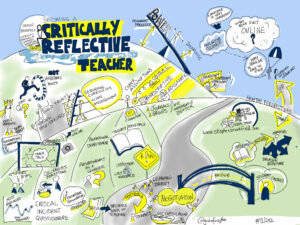How participation in an online academic community can integrate support from peers and tutors in a novel pattern
Training teacher-researchers has become an important agenda in teacher education, as it can promote research-informed teaching and reflective practices. In postgraduate teacher education programmes, academic supervision is vital for fostering preservice teachers’ research ability. However, traditional one-on-one supervision has faced many challenges due to a changing research context: one in which the supervisor-student ratio has decreased, while stress over timely completion has increased.
In this climate, developments in technology provide an opportunity in higher education for re-thinking communication between supervisors and students. Furthermore, as compared with one-on-one supervision, a more collective academic supervision (‘CAS’) can promote collaborative learning. Therefore, we combined technological advancement and CAS to develop an online peer supervision course: one that allowed students to practice research skills in a Moodle-based space. We then conducted a study to examine the underlying mechanism and efficacy of online CAS (‘OCAS’) with Master of Education (MEd) students who majored in Early Childhood Education (ECE).

Designing for ‘Online Collective Academic Supervision’
A “3PBL Teaching Model” was constructed in our OCAS course. It involved problem-based learning, project-based learning, and practice-based learning. Students proposed their research topics and research design. Then they posted research outlines on Moodle, reviewed other students’ outlines, and thereby practised research skills to address their research problems – considering both peers’ and supervisors’ feedback. The OCAS course had the following characteristics:
- Teacher-student learning community: It constructed a learning community with a clear division of labour among students and supervisors;
- Diversified resource sharing: Teachers and students could share diverse resources on the Moodle platform;
- Interaction with learning resources: Students and teachers had access to learning materials, the video recordings of students’ presentations, and research summaries,
- Peer learning: Students could read each others’ work and reflect on their progress;
- Continual evaluations: The Moodle system automatically records all students’ work and discussions.
As we can see, this model of OCAS focuses on students’ and supervisors’ joint involvement and, thus, the development of research skills through resource sharing, knowledge building, and technological support.
How students engaged in our OCAS
A total of 29 MEd students participated in this study. They were preservice teachers who trained at an English language research university in Hong Kong. In addition, the OCAS was integrated in the second semester of a compulsory, 12-hour Research Methods course instructed by one of the present co-authors, who was the specialism coordinator of the MEd programme.
Students’ discussion in the Moodle-based course worked like a traditional asynchronous bulletin board system. Students could post their comments on the discussion board to initiate peer dialogue and interactive learning. At the beginning of this course, students were asked to present their research proposal through a 5-minute video recording and upload it with a bullet point summary page. Other students and the supervisors could watch, read and give feedback after that.
In the 5-minute presentations (and the following interactions), students needed to (1) demonstrate their understanding of the relevant research context and how their research contributes to the research literature; (2) reflect on the strengths and weaknesses of their proposed research and possible problems that they might encounter when carrying out the project; and (3) show their capability to convey ideas precisely and respond appropriately.
After watching the presentation video and reading the summary, students and supervisors could raise questions and give feedback . The presentation and online interaction continued for six weeks. Four to six students did their presentations each week and then discussed their research proposal with peers and supervisors through online posts. Each post shows the student’s name, the posting time, the text of the post, and attachment(s).

Two patterns of feedback support
Our study examined the characteristics of the feedback given by peers and supervisors in the OCAS and, also, how teacher candidates interacted with each other in the process. We collected six week’s of online posts for analysis. To identify the foci of the feedback posted by students or supervisors, we characterised the specific meaning of text segments. Next, we read through the posts and labelled the content, and generated the themes and categories.
After analysing 488 posts, we found that students’ learning is embodied in the online social process promoted by questions from peers and supervisors. In addition, the Moodle platform and instructional design provide support for students to communicate, and improve their research design by integrating feedback from colleagues and supervisors.
Based on the analysis of students’ and supervisors’ online feedback, we found they have different concerns. Yet their feedback can compensate each other for supporting students’ proposed research. For example, supervisors’ online feedback focused on the research topic and research design, whereas students’ feedback asked for more information on how to carry out the research. The former guided the novices’ thinking and helped them know the essential components of a research plan. The latter helped the students construct a practical research plan.
For instance, many of the students’ questions were about the details of data collection and measurement, such as “Did you record a video during the observation process?” and “What questionnaire will you use to investigate your parents’ opinions?” In addition, some questions focused on sampling and participants, such as “How would the child be selected in each workshop?” and “Who are the participants for the interviews?”
Unlike peer feedback, supervisors’ feedback focused on the research topic, methodology, research design, and research questions. On research topics, the supervisor tended to comment on topic selection, such as “This topic is not very new. So, you need to think more and dig deeper to find something new from this topic.” and “Math is obviously a good topic, relevant to a hot topic – STEM”. In terms of data collection and analysis, supervisors also asked for more information, such as “How to observe and measure children’s responses?”.
What form did online interactions take?
In terms of online interaction, 369 interactive behaviours out of 209 posts were from students. We coded discussion using the problem-solving discussion coding scheme to analyse how students and supervisors provide feedback. Most of the interactive behaviours in the feedback (47.1%) were asking questions, such as “why do you design K2 children as your target participants?”; 26% of the interactive exchanges were analysing the contributions of others, such as “It is always exciting to see how technology is integrated into teaching young children concepts, in this case, mathematics.”; 18.7% of the discussion contributions provided information or proposed solutions, such as “after collecting data, I will calculate how many children like this app and how many children think it is easy to use”.
While for supervisors’ discussion, 27.2% of interactions were for providing information or proposing a solution; 24.6% were asking questions or pointing out problems; 24.6% were analysing others’ contribution; 17.5% were discussing existing contribution; while only 6.1% of were making summary or drawing conclusions.
To further analyse the interaction patterns, we adapted another coding scheme and identified three kinds of interacting patterns:
(1) “initiation without response” (I), or posting without being replied;
(2) “initiation-response” (IR), or posting and being replied by the presenter;
(3) “initiation-response-feedback” (IRF) or responding after receiving the presenter’s reply.
Our analysis indicated that 24.3% of the posts had no reply, and only 4.3% further initiated the online discussion. Most of the interactions (70.8%) were IR type. We found that most students gave their opinions or comments after viewing the presentation and summary; however, they did not initiate further discussion after receiving the presenter’s response.
Lessons learned
This research shows how OCAS provides a collaborative learning community that integrates student learning into social networks and promotes feedback from both classmates and supervisors. In the supervision process, the supervisors’ role was as facilitator of knowledge sharing and building. Meanwhile, the students were responsible principal investigators and reviewers, building their learning community and practising academic writing and communication skills.
To support teacher-researchers in coping with the changing needs of schools, the “3PBL” pedagogical design of OCAS provides a space for teacher candidates in postgraduate education to build their research ideas and promote their research skills. This model reflects social learning processes contributed by both students’ and supervisors’ feedback. A participatory pedagogy exists in this OCAS model, which helps students become active learners in knowledge building through taking classmates’ and supervisors’ feedback into account. This in-depth case study succeeds in proposing a more process-oriented approach for collaborative learning, emphasising the participation of supervisors and postgraduate-level teacher candidates in the OCAS.
Acknowledgement: This work was supported by the General Research Fund (Research Grants Council, Hong Kong SAR) under Grant no. 17607517.


Leave a Reply